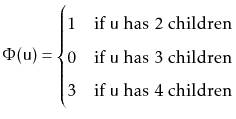Next: 9.4 Discussion and Exercises Up: 9. Red-Black Trees Previous: 9.2 RedBlackTree: A Simulated Contents
The following theorem summarizes the performance of the RedBlackTree data structure:
Not included in the above theorem is the extra bonus
We will only sketch a proof of Theorem 9.2. By comparing
![]() and
and
![]() with the algorithms for adding
or removing a leaf in a 2-4 tree, we can convince ourselves that this
property is something that is inherited from a 2-4 tree. In particular,
if we can show that the total time spent splitting, merging, and borrowing
in a 2-4 tree is
with the algorithms for adding
or removing a leaf in a 2-4 tree, we can convince ourselves that this
property is something that is inherited from a 2-4 tree. In particular,
if we can show that the total time spent splitting, merging, and borrowing
in a 2-4 tree is ![]() , then this implies Theorem 9.2.
, then this implies Theorem 9.2.
The proof of this for 2-4 trees uses the potential method of amortized
analysis.9.2 Define the potential of an internal node
![]() in a 2-4 tree as
in a 2-4 tree as

Next notice that, if we ignore splitting and merging of nodes, there
are only a constant number of nodes whose number of children is changed
by the addition or removal of a leaf. When adding a node, one node
has its number of children increase by 1, increasing the potential by
at most ![]() . During the removal of a leaf, one node has its number of
children decrease by 1, increasing the potential by at most
. During the removal of a leaf, one node has its number of
children decrease by 1, increasing the potential by at most ![]() , and two
nodes may be involved in a borrowing operation, increasing their total
potential by at most
, and two
nodes may be involved in a borrowing operation, increasing their total
potential by at most ![]() .
.
To summarize, each merge and split causes the potential to drop by
at least 2. Ignoring merging and splitting, each addition or removal
causes the potential to rise by at most 3, and the potential is always
non-negative. Therefore, the number of splits and merges caused by ![]() additions or removals on an initially empty tree is at most
additions or removals on an initially empty tree is at most ![]() .
Theorem 9.2 is a consequence of this analysis and the
correspondence between 2-4 trees and red-black trees.
.
Theorem 9.2 is a consequence of this analysis and the
correspondence between 2-4 trees and red-black trees.